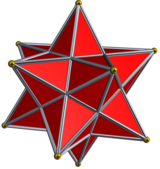
Back نجمة (مضلع) Arabic Зорка (геаметрыя) Byelorussian Polígon estelat Catalan Çăлтăр (геометри) CV Stern (Geometrie) German Αστεροειδές πολύγωνο Greek Stelo (figuro) Esperanto Estrella (figura geométrica) Spanish Izar-poligono Basque چندضلعی ستارهای Persian
 {5/2} |
 |5/2| |
| A regular star pentagon, {5/2}, has five vertices (its corner tips) and five intersecting edges, while a concave decagon, |5/2|, has ten edges and two sets of five vertices. The first is used in definitions of star polyhedra and star uniform tilings, while the second is sometimes used in planar tilings. | |
 Small stellated dodecahedron |
 Tessellation |
In geometry, a star polygon is a type of non-convex polygon. Regular star polygons have been studied in depth; while star polygons in general appear not to have been formally defined, certain notable ones can arise through truncation operations on regular simple or star polygons.
Branko Grünbaum identified two primary usages of this terminology by Johannes Kepler, one corresponding to the regular star polygons with intersecting edges that do not generate new vertices, and the other one to the isotoxal concave simple polygons.[1]
Polygrams include polygons like the pentagram, but also compound figures like the hexagram.
One definition of a star polygon, used in turtle graphics, is a polygon having q ≥ 2 turns (q is called the turning number or density), like in spirolaterals.[2]